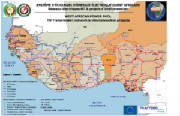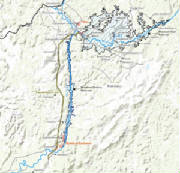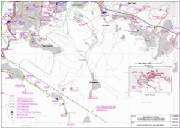Bumbuna Phase II
The
Bumbuna II hydropower project, located on the Upper Seli River in North East Sierra Leone, is the country's largest infrastructure
project and is a key part of the Government of Sierra Leone’s long term Energy Plan.
The project
involves building an extension to the existing 50 MW Bumbuna I facility. When complete, Bumbuna II will add 143MW of new capacity
and, critically, will provide Sierra Leone with a minimum of 80MW of reliable, all-year round affordable electricity.
Construction on Bumbuna II is anticipated to start in 2019 with operations to start within 4 years of the start date.
Seli Hydropower, the local project company jointly owned by Joule Africa and its local partner Energy Services Company
(ESCO,) will be responsible for building, owning and operating Bumbuna II.
In August 2017, Joule
Africa signed a 25 year Power Purchase Agreement (PPA) with the Government of Sierra Leone, marking an important milestone
in the development of the project.
For more information on Bumbuna Phase II Project, please visit www.selihydropower.sl.
The project includes:
- Building an extension to the existing Bumbuna I facility which will include 3 new turbines
- Building a new dam 32 km upstream at Yiben which will include 2 new turbines
- Creating a new reservoir of water behind the Yiben dam wall covering approx. 115 km2
- Creating
buffer zones around the infrastructure to protect the community from potential hazards such as high flood, dust, noise, or
electrocution
- Building improved access roads
Once generated, the electricity will be distributed by a new 225kV transmission line running
from Yiben in the north of Sierra Leone, to Freetown in the West. This transmission line will also link up with the new Cote
d’Ivoire, Liberia, Sierra Leone and Guinea (CLSG) extension, joining up with the West African Power Pool
Western Area Generation and Distribution
Historic Overview of Electricity Distribution
and Supply Authority
The defunct National Power Authority (NPA)
was created by an Act of Parliament in 1982. It was called the Sierra Leone Electricity Corporation. The name National
Power Authority was captioned in the “Supplement to the Sierra Leone Gazette Volume CXIII, Number 17, and dated 25th
March 1982”. NPA was described as an autonomous body that generates, transmits, distributes and supplies electricity
throughout the country. The
core business of NPA was to ensure the provision of safe, reliable, adequate, environmentally compliant and affordable electricity
supply to its residential, commercial and industrial customers. The population of Sierra Leone has grown from 2.5 million
people in the early 1970s to approximately 6.3 million in 2013 (est.).
Because of the challenges faced by the
former NPA in providing electricity services, a National Electricity Act was promulgated in 2011 by parliament which saw the
unbundling of the vertically integrated NPA into two entities, that is, the Electricity Generation and Transmission Company
(EGTC) and the Electricity Distribution and Supply Authority (EDSA).
Functions of the Electricity Distribution
and Supply Authority
- Be responsible for the supply, distribution and retail sale of electricity for the
entire country except in areas which the Commission has issued a distribution licence to another appropriately qualified entity.
- Be responsible for dispatch and system control of electricity within its territory.
- Establish as far as is practicable uniform standard voltages throughout its area of supply
- Secure the supply of electricity at reasonable prices.
- Carry on any business usually associated with electricity distribution and supply.
- Promote and encourage the economic and efficient use of electricity, especially for domestic, commercial, agricultural,
industrial and manufacturing purposes.
- Perform any other functions incidental
or consequential to its functions under the 2011 Act.
Note here that EDSA shall purchase electricity from the Electricity Generation and Transmission Company (EGTC) and Independent Power Producers (IPPs) subject to a power purchase agreement approved by the Commission.
At the moment the installed
generation capacity under the management of EGTC is 99.28MW, whilst available capacity is 64.28MW nationwide. Freetown, the
capital city enjoys about 87.9% of the total available capacity
C.
CRITICAL CHALLENGES - 2014-2017 Hon Minister Henry Macauley's report.
While the country had suffered from inadequate power generation capacity for many years, the
transmission and distribution of the power generated had also been a major challenge. Hence, improvements to the transmission
and distribution systems remain a critical component of efforts to increase the supply of electricity.
Policy & Legislation
The need for a realistic re-evaluation of both policy and strategic targets, updating existing policies (Energy
Policy 2009), and assigning responsibilities to the correct entity where necessary, with an emphasis on implementation.
The need to develop further policy where gaps exist, particularly rural electrification and private sector investment
and where clarity or enhancement are required, such as independent regulation, cost-reflectivity within tariffs and completion
of sector structural reforms.
A requirement for enhancing primary legislation (Electricity Act and EWRC Act)
to capture the policy reforms above.
A requirement to develop secondary legislation (both economic and technical)
and industry agreements, particularly those which are essential to encourage and facilitate private investment, drive performance
improvements in distribution, facilitate off-grid solutions, and strengthen sector structure reforms.
Regulation
A lack of capacity and inadequate staffing in the regulator, meaning EWRC is not yet in position to fully exercise all its
functions and powers.
EWRC is not, therefore, presently in position to be fully independent, and will not be
until it has built sufficient capacity (and the electricity market has developed).
An absence of performance based regulation in place, specifically tariff
regulations, which are still to be established by EWRC
Planning
Insufficient staffing, data and processes
or work methodology within the Ministry of Energy to undertake integrated resource planning.
Absence of a supporting
framework which offers direction for sector-wide roles and responsibilities in the sector planning process.
No planning or incentive scheme in place for alternatives (off-grid / mini-grid / solar home system) particularly in rural
areas.
Generation
Insufficient funding, as a result of arrears from EDSA, impacts on operational performance
due to an ability to procure fuel supply.
Generation Procurement
The sector presents certain dis-incentives
to investment because of (amongst other reasons) a dependency on government subsidies and external financial support, low
wholesale tariffs and regulatory uncertainty.
An unstructured and complex procurement process which unnecessarily
increases procurement timelines and investor costs.
A least cost extension plan is required to ensure demand
can be met over medium term.
Transmission
& System Operation
Lack of a grid code, which is essential for ensuring a level playing field for IPPs in
terms of compliance with technical connection requirements, access to the grid, order of dispatch, and clarity in terms of
the costs of wheeling power.
Transmission still bundled with generation presenting poor incentives for performance
improvement in terms of improving technical and commercial efficiency.
Distribution & Retail
High losses
in the distribution system, due to metering and billing problems, inefficient system of chasing thefts, illegal connections,
meter tampering and malpractice.
Lack of reliable data within EDSA hampering attempts at improved commercial
management.
Inefficient connection process which acts as a barrier to new customers.
Sector Structure and
Finances
Lack of complete accounting asset unbundling and inability to produce audited financial statements,
preventing access to finance for utility investment.
The absence of a formalized PPA between EGTC & EDSA
is damaging to the sector, as it causes deep uncertainties through the entire value chain and impacts directly on electricity
supply.
The outstanding implementation of the collections account is impacting financial sustainability across
the value chain.
Off-Grid
The absence of a clear institutional framework for the organised development
of off-grid solutions in the distribution sector in Sierra Leone.
Current business models and underlying technologies
are not optimal to support the universal access objective of the government,
Planning to date has not been informed
by a willingness-to-pay study,
Communications
Lack of a pre-defined communications strategy which can disseminate the sector’s vision and/or objectives.
Insufficient investment in communications function which extends to human capacity and institutions’ abilities
to execute this activity.
To date, only about 13 percent of the population is estimated to have access to electricity
from the national power grid. Moreover, there is high seasonal variability in hydroelectric power production.
With extended
functions, activities and programmes of the Ministry, inadequate allocation of resources to the Ministry is also a critical
challenge.
Human resource is also another critical challenge faced by the Ministry. The activities of the Ministry extend
everyday with limited manpower and incentives for staff especially that of a technical Ministry serving as the back bone for
development.
Abstraction of Electricity is another serious challenge that has created inefficiencies in delivery and
service.
D. NEXT STEP /FUTURE DIRECTION
The Ministry will continue to collaborate with development partners, NGOs,
investors and Independent Power Producers to increase reliable, affordable, adequate and cost-effective electricity supply
country-wide. This can only be achieved with adequate investment in energy. To this end, the Ministry continues to encourage
stakeholders;, Independent Power Producers and investors in the energy sector.



